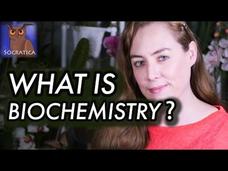Ancient Lights Media
Photosynthesis: The Light-Dependent Reactions
Plant Physiology and Chemistry Set: 2. This clip provides an in-depth look at the details of the light-dependent Biochemical reactions of photosynthesis,
Ancient Lights Media
Photosynthesis: The Light - Independent Reactions
Plant Physiology and Chemistry Set: 1. This clip explains the light independent biochemical reactions of photosynthesis that result in the production of energy rich glucose.
Catalyst University
Biochemical Mechanism of the Smell of Death | How do Bodies Decay?
In this video, we will discuss the stages of corpse decomposition and also the molecules (and their biosynthetic pathways) that contribute to the smell of a dead, decaying body.
Catalyst University
Microbiology Lab | Starch Hydrolysis Test (via Amylase)
Here we look at the reaction and results of the Starch Hydrolysis Test in Microbiology Lab.
Curated Video
Why Do Touch-Me-Not (Mimosa Pudica) Leaves Close When Touched?
Mimosa pudica bends upon being touched. This occurs due to changes in the turgor pressure in its cells. The behavior is a predator avoidance mechanism. Mimosa pudica is a perennial herb of the Fabaceae pea family, native to Central and...
Catalyst University
Enzyme Inhibitors | Mechanisms, Michaelis-Menten Plots, & Effects
In this video, we will discuss the mechanisms of different types of biochemical inhibitors, how to interpret their Michaelis-Menten plots, and their effects on Vmax and Km of enzymes.
Science360
Monitoring multiple biomarkers at once – Biotech’s future
NSF-funded small business Applied Biosensors has created sensors that continuously monitor multiple biomarkers. The core technology has implications for biomedical research, water quality management and metabolic monitoring, among...
Curated Video
Energy Transformation in Living Beings
It describe the Energy Transformation in Living Beings.
Ancient Lights Media
Restriction Enzymes/Introduction to Enzyme Function
Restriction Enzyme Set: 1. This clip introduces DNA-snipping restriction enzymes and takes a simplified look at how enzymes function.
Curated Video
Enzymes 1
It introduces enzymes as the biological catalyst. It also describes their chemical structure, types, nomenclature and mechanism of action.
Curated Video
Catalysis
It explains the process of catalysis. It describes the homogeneous and heterogeneous catalysis. It discusses the adsorption theory of heterogeneous catalysis.
Curated Video
How to Get Rid of Skunk Smell
Skunks are nocturnal animals that prefer to keep to themselves. However, when they sense danger, this lurking purveyor of biochemical warfare unleashes its primary defense mechanism: a nasty-smelling spray. Similar to tear gas, the scent...
TED-Ed
TED-ED: Could a breathalyzer detect cancer? - Julian Burschka
How is it that a breathalyzer can measure the alcohol content in someone’s blood, hours after they had their last drink, based on their breath alone? And could we use this same technology to detect disease by analyzing a person’s breath,...
TED-Ed
Nature's Smallest Factory: The Calvin Cycle
Explain the two-step process of photosynthesis to your high school biologists with a focus on the Calvin cycle. Using adorable animation, a video likens the cycle to a tiny, sustainable factory. Even though the enzyme-bird rubisco and...
American Chemical Society
What is Addiction?
Why do our bodies become addicted to some substances? Young psychologists explore the mechanisms of addiction through a video from the American Chemical Society's Reactions series. Content includes the cycle of addiction, changes that...
Curated OER
ATP: Adenosine Triphosphate
Here is accessible, understandable information about ADP and ATP. By explaining how ATP is hydrolyzed, Sal Khan is able to demonstrate how energy is released into a cell.
Socratica
What Is Biochemistry?
Watch as chemistry comes alive! Socratica's biology playlist kicks off with a simple video detailing the principle components of biochemistry. Content includes carbohydrates, proteins, and nucleic acids. The narrator describes each class...







